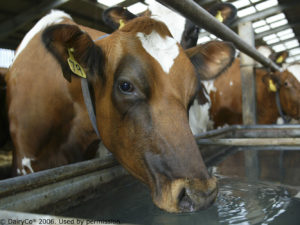The Importance Of Water
1 February 2017We are all aware of the importance of adequate, clean drinking water. Unfortunately advice on water requirements for beef cattle is often simply taken from the recommendations for dairy cows – which bare little or no relationship at all to the water requirements of beef cattle. For example a high yielding dairy needs to drink around 150 litres of water a day! Whereas a dry spring calver on baled silage only needs to drink 30 litres per day. Even at peak lactation on a dry straw and concentrate ration on a hot day the beef cow still requires less than half of the water needed by the much higher yielding dairy cow.
The other problem, unique to dairy cows is the periods of the day when they are shut away from water supplies in the collecting yard ready for milking.
Combining the much higher daily requirement with the shorter period of access means dairy producers are advised to have 15 cm of water trough for every cow in the herd so 10% of them can all drink at the same time. Transferring such recommendations to beef cattle is not only unnecessary but can even be counter productive. The longer the trough –
- The higher the risk of contamination with dung and potential spread of diseases such as Johne’s.
- The greater the contamination with other material eg bedding, silage, etc.
- The more difficult it is to keep clean and the greater the volume of dirty water which has to be removed.
- The greater the risk of freezing due to the slower rate of filling.
- The greater the risk of young calves/lambs getting into the trough and drowning.
Taking all these factors into account an allowance of 1 inch per head (2.5 cm per head) would appear more than generous equating to 3 foot of trough space per pen of around 35 cows.
Depth Of Water
Interestingly the recommended depth of water in a trough for cattle is just 3 inches! The argument is that 3 inches is deep enough for cows to have their muzzle fully submerged while they are drinking. The dairy recommendation goes further “depth of water should not exceed 12 inches in order to prevent stagnant water collecting and to make cleaning of troughs more easy.” This raises the question why are nearly all water troughs so big? (My guess would be that originally big troughs helped “store” water when water supplies were poorer? Since the first one or two were mass produced everybody else has simple followed the same pattern without thinking about it in detail.) Another advantage of troughs being just 4 – 6 inches deep would be that they would be a lot cheaper to produce.
Ideal Water Trough
- Semi-circular with an 8 inch diameter to give a 4 inch depth providing there is a good water supply and flow rate ie greater than 10 litres per minute..
- The inflow would be at the base at one end and the outflow at the base at the other end. The inflow would come from a completely insulated master tank and ballcock. The outflow would go to outside the building where a simple tap would be fitted for when the troughs are cleaned out.
- The master tank would be set to give 3 inches depth of water in the troughs.
Basil Lowman, basil.lowman@sac.co.uk
Sign up to the FAS newsletter
Receive updates on news, events and publications from Scotland’s Farm Advisory Service

